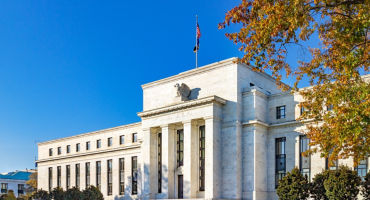- Fixed Income Analyst
Skip to main content
- Funds
- Insights
- Capabilities
- About Us
- My Account
The views expressed are those of the author at the time of writing. Other teams may hold different views and make different investment decisions. The value of your investment may become worth more or less than at the time of original investment. While any third-party data used is considered reliable, its accuracy is not guaranteed. For professional, institutional, or accredited investors only.
The Federal Open Market Committee (FOMC) raised the target federal funds rate by 75 basis points (bps), to a range of 2.25% to 2.50%, at its July 2022 meeting. The FOMC made no change to its plans regarding the ongoing reduction of its balance sheet, which began in June.
The rate increase, which was largely priced into markets, occurred as US inflation rose and the labor market remained strong. In recent weeks, however, manufacturing data has signaled slowing US economic growth. In addition, the US Treasury (UST) yield curve has inverted, meaning that the yield on shorter-dated UST debt now exceeds the yield on longer-dated UST debt — which, historically, has often portended recession.
The US Federal Reserve’s (Fed’s) own models of economic growth and inflation suggest that the risk of stagflation — rising inflation paired with falling growth — has increased. Going into the July meeting, the Atlanta Fed’s GDP measure indicated that the rate of change for second-quarter GDP was negative, while the New York Fed’s GDP measure showed slowing growth since the June FOMC meeting. At the same time, the most recent print of the Dallas Fed’s Trimmed Mean Personal Consumption Expenditures (PCE), an important gauge of core inflation pressures, came in at 4.0%. Most concerningly, it indicated that over half of the component prices of PCE had increased at an annual rate of more than 5%.
Taken together, these datapoints present a dilemma for the Fed. On one hand, signs of moderating economic growth suggest that removal of monetary policy accommodation could increase the risk of a US recession. On the other hand, the momentum in inflationary pressures implies that failure to remove policy accommodation could cause inflation expectations to increase.
While slowing manufacturing data and an inverted UST yield curve can be leading indicators of a recession, not all of the available data suggests that a recession is imminent or inevitable. In particular, the Fed is attentive to the continued resilience of the US labor market: The unemployment rate has remained near historic lows at 3.6%, while workers’ wages have continued to increase (although wage growth is negative in real terms). Initial jobless claims have ticked up slightly of late, but remain well below the elevated levels that prevailed for most of 2020 and 2021. Until the labor market deteriorates meaningfully, the Fed will likely continue to prioritize the removal of monetary policy accommodation in an effort to combat inflationary pressures.
When the Fed pivoted from enacting a 50-bps rate hike to a 75-bps hike at its June FOMC meeting, Chair Jerome Powell cited upward moves in survey-based measures of inflation expectations as a key driver of its policy shift. Since that time, survey-based measures of inflation expectations have come off their highs but remain elevated. Likewise, Treasury Inflation-Protected Securities (TIPS)-implied “breakeven” rates have dipped as energy prices have stabilized, but both the 5-year and the 10-year breakeven rates remain solidly above 2% as of this writing.
Indicators of inflation expectations will continue to be important inputs to Fed monetary policy going forward. Given the uncertainty about the economic outlook, the Fed would prefer to hike rates as little as possible, provided inflation expectations remain consistent with its mandate to keep average inflation at around 2%. Any material increases in inflation expectations would likely necessitate more aggressive removal of policy accommodation, whereas material decreases could bring the Fed’s current rate-hiking cycle to an earlier end than what’s now priced into markets.
In addition to its “price stability” and “maximum employment” goals, the Fed also takes its “financial stability” mandate seriously. With market volatility elevated and apt to remain so, the Fed will try to avoid contributing to that volatility with its words and actions, if it can. Absent an exogenous macro shock, I expect the Fed’s balance-sheet normalization to proceed as planned for the next few months. Its monetary policy will be informed by both incoming inflation data and labor market data. Given that recent data indicates more change in the former than the latter, the risk to interest rates for the foreseeable future appears to be to the upside.

Chart in Focus: Is the Fed rate cut positive for risk?
Continue readingThe Fed architecture under scrutiny: What are the investment implications?
Continue readingTwilight zone: how to interpret today’s uncertain macro picture
Continue readingStagflation watch: Thoughts on tariffs, inflation, and Fed policy
Continue readingURL References
Related Insights
Stay up to date with the latest market insights and our point of view.

FOMC: Easing into uncertainty
Fixed Income Portfolio Manager Jeremy Forster profiles the Fed's December rate cut, labor market trends, inflation pressures, and the role of anticipated changes to FOMC leaders in 2026.

Chart in Focus: Is the Fed rate cut positive for risk?
In this edition of Chart in Focus, we examine how the Fed’s long-awaited interest rate cut may influence risk assets.

The Fed architecture under scrutiny: What are the investment implications?
Macro Strategist Juhi Dhawan looks at how changes in the Federal Reserve's personnel and decision making could impact policy, the US dollar, and financial markets.

FOMC: Cushioning the US labor market
Fixed Income Portfolio Manager Jeremy Forster analyzes the Fed's decision to cut interest rates at the September FOMC meeting.

Twilight zone: how to interpret today’s uncertain macro picture
Macro Strategist John Butler and Investment Director Marco Giordano explore how to interpret today’s uncertain macroeconomic picture and its key implications.

Rethinking the Fed’s dual mandate
Is it time for a fresh perspective on the dual mandate? Fixed Income Portfolio Manager Brij Khurana explores the potential benefits of reorienting monetary policy toward maximizing productivity.

Stagflation watch: Thoughts on tariffs, inflation, and Fed policy
US Macro Strategist Juhi Dhawan considers signs the US economy may be moving toward a toxic mix of slowing growth and rising inflation, creating challenges for the Fed and investors.

Severance: The split between the economy and the markets
While markets have bounced back since Liberation Day, policy changes and macro data bear watching. Heading into the second half of 2025, we're focused on relative opportunities across asset classes created by disconnects and divides between markets and economies.

Oh baby, baby, it’s a wild world
Just one quarter into the year, many policy and economic assumptions have been turned on their head. What does it all mean for equity, bond, and commodity markets around the world? Members of our Investment Strategy & Solutions Group offer their outlook.

Fed delivers rate cut, but hawkish 2025 guidance sends yields up
Fixed Income Analyst Caroline Casavant examines the outcome of the December 18 Federal Open Market Committee meeting and the implications for rates, inflation, and real growth.

Going their separate ways: Capitalizing on bond divergence
Our fixed income experts discuss how to position portfolios for a world of uncertainty and divergence, exploring key themes and evolving bond opportunities for 2025.
URL References
Related Insights